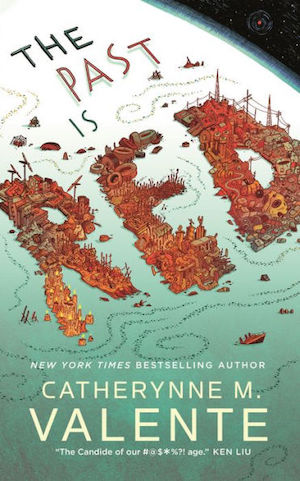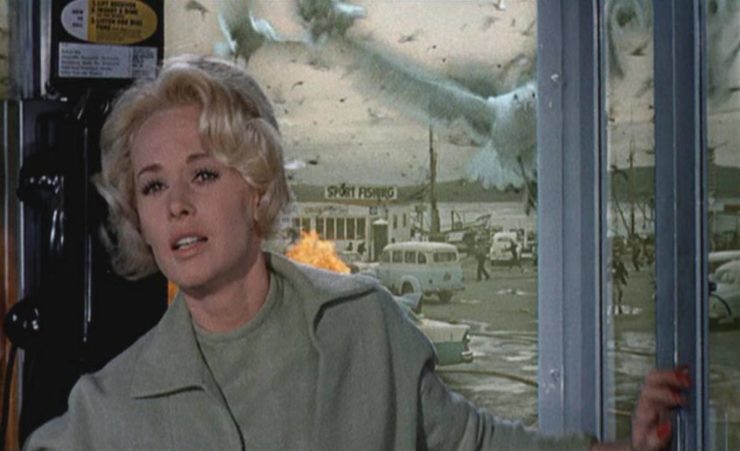The horror genre loves punishment. Daphne du Maurier’s famous 1952 short story “The Birds” is hardly alone in unleashing a judgement upon the whole human race, but it delivers its damnation with a distinctive, deftly mysterious economy. Set in rural Cornwall, the narrative follows part-time farmhand Nat Hocken, who hears strange sounds from his children’s bedroom one winter night. Entering, he sees the window is open, and the next moment realizes his boy and girl are under assault by apparently crazed birds. Things escalate rapidly from there, and soon the country, and apparently all of civilization, have collapsed beneath a blind but determined onslaught of beaks and talons wielded by thousands, tens of thousands, hundreds of thousands of sparrows, gulls, finches, gannets, all seized not so much by madness as by a blank determination to exterminate.
The story is clearly inspired by, and something of an analogy for, World War II. Nat is a veteran, and he mentions the Blitz more than once, comparing the bird attacks to “air raids in the war.”
The parallel with air raids isn’t meant to emphasize the destructiveness of the attacks, though. Nat compares the two events because of the way that those who weren’t caught in the violence didn’t understand, or really believe, what it meant when bombs were falling. Faced with the disinterest of his neighbors, Nat thinks, “No one down this end of the country knew what the Plymouth folk had seen and suffered [during the raids]. You had to endure something before it touched you.” People are blind—like Nat stumbling around in his children’s room, his head covered by a blanket to protect himself, lost and confused (“how long he fought with them in the darkness he could not tell….”) More, people are callous and smug in their blindness, complacently musing, “Never heard of birds acting savage,” as if never having heard of it in the past provides protection for the future. Ned’s neighbors refuse to board up their windows. They cheerfully grab their guns to go shoot at the massing gulls, like it’s a hunting holiday, as if one rifle is protection against what is coming.
Ned’s resentment, and the story’s, is in part a reflection of the soldier’s grim alienation from the civilian he’s left behind. You can read “The Birds” as Ned’s grim fantasy of his neighbors finally learning firsthand what he suffered in the war.
But du Maurier was also clearly inspired by Britain’s failure to take fascism seriously enough at the beginning of the war. Humans weren’t ready then, and they won’t be ready, she suggests, if something else, something even more apocalyptic, comes along. It’s not just the farmers next door, but the BBC announcer in London with the “smooth and suave” voice who fails to appreciate the danger. Until at last he does appreciate it, and then shortly thereafter there is no voice on the radio at all. No one but Ned seems to understand that the world has turned hostile and inimical, until it’s too late, and those neighboring farmers lie dead in their homes, their windows shattered around them, their guns lying useless beside them.
Du Maurier’s evocation of nature suddenly massing against us is one of the most evocative passages in the story:
What he had thought at first to be the white caps of the waves were gulls. Hundreds, thousands, tens of thousands… They rose and fell in the trough of the seas, heads to the wind, like a mighty fleet at anchor, waiting for the tide.
The ocean itself is made animate, the mute waves waiting to take wing and send death into the sky with silent efficiency. In comparison, Ned muses that with the government, and with everyone else, it’s always, “Muddle, muddle from the start. No plan, no real organization.” Humanity is weak, unprepared, lacking in coordination and invention. All that it takes is for the earth, or the sky, to turn one beady eye upon us, and our own foolishness and ineptitude comes upon us like a penance.
Alfred Hitchcock’s 1963 movie The Birds is only very loosely based on du Maurier’s story. But though it’s set in the coastal California town of Bodega Bay rather than in England, the film does picks up on some of du Maurier’s themes. As in the short story, people in Bodega Bay are slow to believe the birds are coming, and they suffer as a result. An amateur ornithologist (Ethel Griffies) is particularly vocal about the impossibility of a massed bird attack—their brains aren’t big enough, she insists. We last see her cowering in the back hall of a diner, her back turned away in grief, shame, and terror.
Buy the Book


The Past Is Red
Still, Hitchcock isn’t really interested in condemning humanity in general, à la du Maurier. For one thing, his bird apocalypse is restricted to the one town; it doesn’t even encompass all of California, much less the world. The truth, though, is that the film’s logic of retribution is even more narrow than that suggests. The film is interested not in the sins of the town of Bodega Bay, but specifically in the sins of one protagonist, Melanie Daniels (Tippi Hedren).
We first meet Melanie in a bird shop in San Francisco, where she’s trying to purchase a myna bird as a gift. When Mitch Brenner (a blandly irritating Rod Taylor) mistakes her for the shopkeeper, she immediately and impulsively tries to fool him into thinking she’s a clerk. He quickly turns the tables on her. He is, it turns out, a lawyer, who was in court on the day she was brought up on charges for a practical joke which resulted in the destruction of a plate glass window. He is teaching her a lesson, he says. She has been high-spirited, improper—as the beautiful, wealthy, reckless daughter of a newspaper magnate, she is entitled and out of line. It’s up to a man to put her in her place.
That man is Mitch. But it’s also Hitchcock, whose film functions as a kind of clever, clockwork trap for Melanie. Incensed by and (somewhat unaccountably) attracted to Mitch, Melanie takes down his license plate number, figures out he has a house in Bodega Bay, and decides to drive up the coast with a gift of two love birds for his little sister’s birthday. She rents a motorboat to go across the bay to his back door, and it’s while she’s returning that the first bird attack occurs. A gull swoops down and strikes her head just as she’s about to reach land, leaving a stream of blood against her blonde hair and perfect features.
“Blondes make the best victims,” Hitchcock famously stated with lascivious malice. “They’re like virgin snow that shows up the bloody footprints.” The first red stain is only a start, though. By the end of the movie, Melanie has been rendered virtually catatonic by repeated bird attacks. Her independent mischievousness and irresponsibility has been pecked out of her. She clings to Mitch, bandages around her head, helpless and inert. Her unruliness has been thoroughly disciplined.
The movie isn’t particularly coy about the way it targets Melanie. One mother in Bodega Bay, driven to distraction, accurately points out that the attacks started when Melanie came to town, and then escalates, “Where did you come from? I think you’re the cause of all this. I think you’re evil! EVIL!”
That terrified, hyperbolic accusation takes on even more sinister overtones given the relationship between Hitchcock and Hedren in real life. The actress says that Hitchcock was “obsessed” with her. In The Birds, their first film together, he made repeated sexual overtures to her, and became angry when she refused him.
Hedren believes he got revenge while filming the climactic scene of the movie, in which Melanie opens an attic door and is attacked by birds who have come in through a hole in the roof. The sequence was supposed to use mechanical birds. But when they didn’t work, Hitchcock tied real birds to her, who pulled and pecked in their panicked efforts to escape. The scene was “brutal and ugly and relentless,” Hedren said. As a viewer, when you watch Melanie struggle and shriek and collapse onscreen, you are literally seeing Hitchcock abuse Hedren. When she collapses, broken, on camera, you’re seeing his fantasy of subjugation.
Knowing the background of the attic sequence makes it sickening to watch. But even without the biographical detail, the sense of cold, deliberate misogyny is what gives the movie its particular sense of poisoned brutality. An early scene, in which an older man rides with Melanie in an elevator, and casts repeated furtive glances, checking her out, is meant as something of a joke. But it also encourages you to see, not from Hedren’s perspective, but from the view of someone, or something following her—it’s Hitchcock’s cold, clinical equivalent of those slasher movie-style shaky cam shots.
Later, in a very celebrated sequence, Melanie sits on a bench near a playground smoking a cigarette, gazing off into the distance. You see one crow fly past to rest on a jungle gym, then another, as Melanie remains oblivious. Finally, she turns around, to see the jungle gym completely covered with crows. They watch her beadily, like that man in the elevator, or like Hitchcock, or like the people in the audience, all waiting to see her reduced to that red smear on the snow.
Du Maurier thinks the humans in her story deserve their fate, but she views her apocalypse from the perspective of those about to be exterminated. Ned sits in his house listening to the birds tearing at the wood of the door as he “wondered how many million years of memory were stored in those little brains, behind the stabbing beaks, the piercing eyes, now giving them this instinct to destroy mankind with all the deft precision of machines.” He’s the small animal looking up, stunned by the majesty and power of the thing diving out of the sky above him. Humans get what they deserve, but the story positions you among those experiencing those terrible, if just, deserts.
The movie The Birds, in contrast, isn’t necessarily taking a human-eye view. One of the film’s most dramatic shots is a bravura look down from high above the town of Bodega Bay. Gulls flap and soar past the camera, and you are with them, gazing down upon the burning town.
Both versions, “The Birds” and The Birds, are interested in doling out punishment, but of all the changes between page and screen, the key difference lies in how that punishment is meted out, and to whom. In du Maurier’s story, the world and its birds have judged humans and found them—us—wanting. In the movie, the judge is Hitchcock himself, ready to swoop down upon his blonde target and tear away at her spirit and independence, reducing her at last to a perfectly silent, bloodied victim.
Noah Berlatsky is the author of Wonder Woman: Bondage and Feminism in the Marston/Peter Comics (Rutgers University Press).










